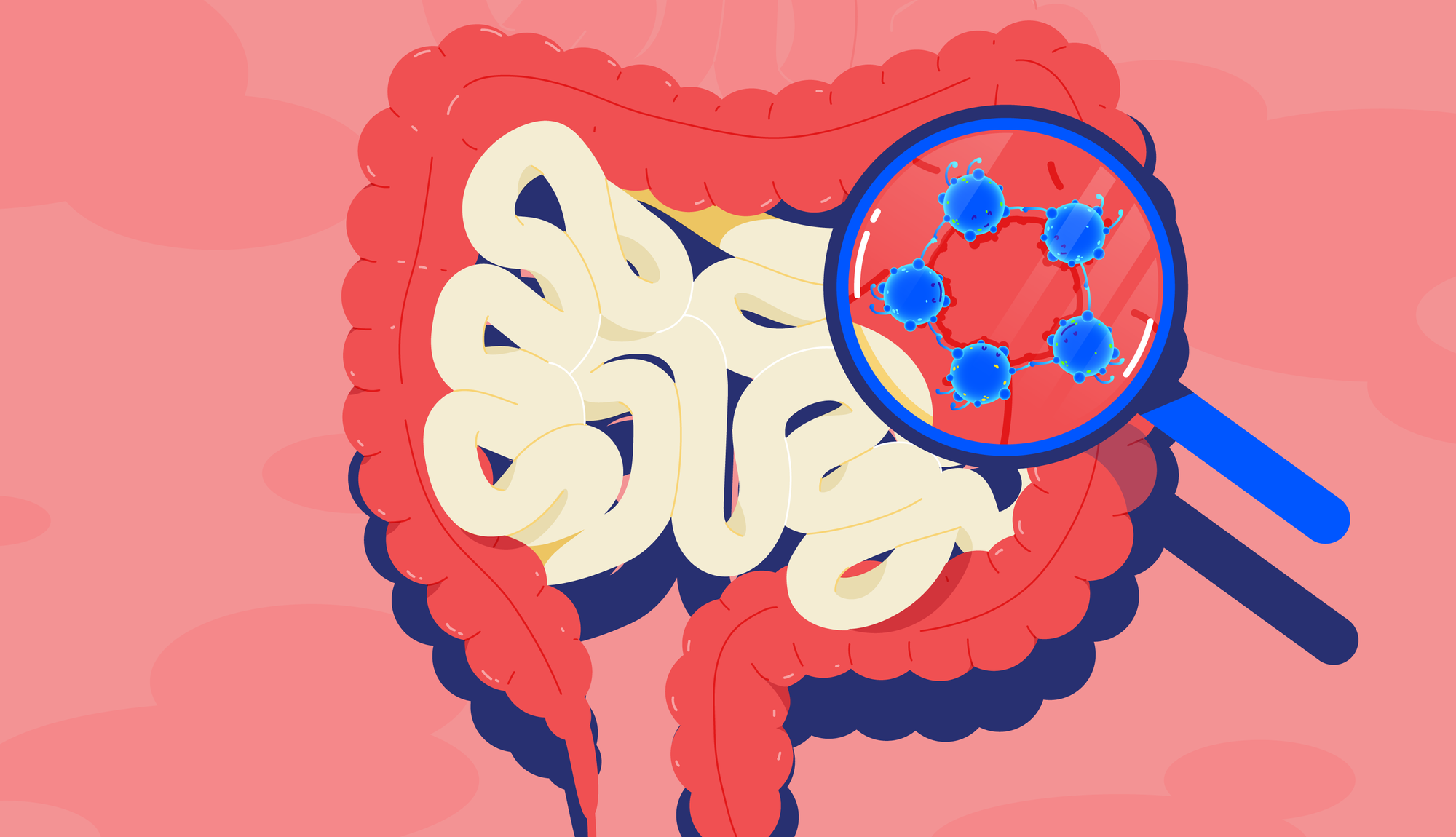The bacteria in your gut do more than just break down prebiotic fibers into important substances, they can even influence how genes work.
Gut health is all the rage, and the microbiome is an important part of that. Yet, the powers of our bacteria extend far beyond manufacturing substances for wellbeing. They’re even involved in our circadian rhythm, the 24-hour clock that regulates the entire spectrum of our bodily functions.
This week’s edition of Science Bites caters to our two favourite subjects, genes and gut bacteria, as we dissect a study on how the activity of bacteria can turn up or down the work of genes in the cells of the small intestine.
Table of contents
- 1. What is a circadian rhythm?
- 2. Genes in your small intestine
- 3. Microbiome programs your clock?
- 4. It enhances nutrient uptake
- 5. Germ-free mice gain less weight
This research was conducted in mice, not humans, who were created for this purpose. Some had gut microbiomes, others had sterile insides. Some had specific genes, and others didn’t. This ultimately allowed the scientists to assess the function of genes and compare it with the activities of bacteria.
Mice share many genetic similarities with humans, and the study of living creatures is a necessary step in the investigation of human health. So, let’s dive in and see what they found.
Circadian rhythm 101
Before we bring you up to speed on this research, let’s review some basics about the circadian rhythm and how genes work.
In this study, researchers looked at gene expression, the process by which the instructions in our DNA are converted into functional products called proteins. Our genes don’t function all the time, instead they increase or decrease their expression depending on the time of day.
The timing of these essential functions is regulated by clock genes, whose sole job is to tell your genes when to work, and when to leave the playing field to other genes. If we take the example of the digestive system, it primes them for breaking down your daily meals, but also leaves time for maintenance and repairs.
Your clock genes work on (roughly) a 24-hour cycle, but they depend on external stimuli to regulate the body’s functions. This cycle is determined on exposure to light, which lets the body know what to do during the day and at night.
Genes in your small gut
While much microbiome research focuses on bacteria in the colon, there are also microbes in your small intestine. This is where the researchers looked for answers.
The researchers chose to analyse activity in the small intestine, the organ that extracts and absorbs most nutrients and energy from our food, and see if and how bacteria could influence the circadian rhythm.
They started with chromatin, a substance found in cells that helps regulate the circadian rhythm. It periodically takes in proteins called histones when it wants to turn off gene expression. That’s how gene activity is regulated to work at specific times of the day.
Your cells contain genes and gut bacteria can influence their work
So, these scientists decided to see whether bacteria in the small intestine could influence aspects of our digestion (like energy extracted from macronutrients) by acting on the genes in the cells of the gut lining, called epithelial cells.
The genes investigated were responsible for important metabolic functions: nutrient uptake and lipid metabolism. The researchers hypothesised that, if these genes were deregulated by microbial activities, they could influence a person’s weight and disease risk.
In order to measure changes in the daily circadian cycle of these gene activities, they collected epithelial cells of the lining of the small intestine from 2 sets of mice over a period of 24 hours.
One group of mice were conventional: their microbiome had developed normally. The other mice were germ-free, meaning they had no microbiota and lived in a sterile environment.
The microbiome programs digestive genes
When the scientists compared the level of gene activity in the collected cells over the 24-hour period, they found some interesting results.
The cells of conventional mice showed that gene expression for specific functions rose and declined rhythmically (a term called “oscillation”). In contrast, the gene expression of germ-free mice remained higher, and didn’t vary a lot throughout the 24-hour period.
This indicated that gut bacteria likely influence the circadian rhythm of digestive cells by affecting histone production. Remember, when histones are released by cells, they inhibit gene activity, which is probably why gene expression in the germ-free mice was consistently high in both cell samples.
There are several different histone deacetylase (HDAC - this protein’s full name), and the study found that one specific type was particularly affected by the absence (or indeed, presence of microbiota). It is called histone deacetylase 3 (#HDAC3).
In essence, the researchers found that gut bacteria are able to program the daily rhythm of small intestine activities by inducing the production of HDAC3 (which periodically turns off gene activity). Without it, the genes remain active throughout the day.
This is not ideal, as we’re going to see in the next part - because HDAC3 plays a role in turning on and off lipid absorption and nutrient uptake, so disrupting this process could be linked to diseases like obesity and diabetes type II.
Nutrient absorption
To check how the microbiome could influence our digestive functions via HDAC3 production, the researchers created mice without this protein and recorded what happened.
Indeed, the study used special mice which had no HDAC3 gene in their gut epithelial cells (so they couldn’t make HDAC3), and they confirmed what they found in germ-free mice: gene expression is continually activated. And this isn’t a good thing.
It's not just what you eat, but what the body and bacteria do with it
HDAC3 inhibits the activity of genes that transport specific nutrients in the small intestine, and by doing so, it regulates when and how much the body absorbs. In mice without HDAC3, their nutrient uptake did not fluctuate as it did in conventional mice.
From this comparison, the researchers concluded that gut microbes likely influence nutrient uptake in the small intestine too, via this same pathway. In particular, HDAC3 was shown to influence tyrosine (an amino acid), inositol (a vitamin-like substance), and vitamin B2 (riboflavin) uptake.
| Nutrients | Function |
|---|---|
| Tyrosine | Aromatic amino acid found in many foods, including cheese. |
| Inositol | Vitamin-like substance found in the brain and other tissues. |
| Riboflavin (B2) | Vitamin used for energy supply and to break down macronutrients |
They can also act indirectly by breaking down compounds and making them into substances that are used by the body like making butyrate from prebiotic dietary fibers. They can even turn antioxidant polyphenols into active substances that the body can absorb.
Lipid metabolism
HDAC3 activity turns up and down the activity of 35 different genes in small intestinal cells with positive and not-so-positive consequences.
HDAC3 is involved in regulating the activity of several genes involved in lipid metabolism, from absorption to storage. In fact, mice without HDAC3 didn’t have the trademark oscillation in lipid metabolism.
In mice genetically designed without HDAC3, 17 genes for lipid oxidation and lipid biosynthesis had higher overall expression, meaning that without HDAC3 to regulate gene activity, the body made more fat (biosynthesis) and broke down more fat (oxidation).
However, 18 other fat-related genes actually displayed less activity in mice with no HDAC3. This affected genes responsible for transporting fats into the body and processing them. So after eating, more fat left the gut in their stool, and less entered the body.
When they fed conventional and HDAC3-free mice a high-fat diet, only the conventional mice gained weight. The researchers explained it like this: HDAC3 probably enabled obesity in these mice by enhancing intestinal lipid absorption.
Many studies have already identified links between body weight and the gut microbiome of the colon. For example, Akkermansia muciniphila and Christensenella minuta are two microbes associated with lean body mass, which researchers suggest have a protective role against obesity.
This study confirms such suspicions, and add another clue to the mystery of how, why, and is it possible to manage and manipulate these interactions in the interests of human health.
Conclusions
The gut microbiome doesn’t just act directly on our health by maintaining the gut environment and making nutrients, it influences our genes too.
While more research is required to identify exactly how gut microbes affect HDAC3 production, this study shows that they can by comparing what happens in mice with and without a microbiome, and then evaluating the role of HDAC3 in mice that produce it and those that didn’t.
In particular, the researchers highlighted that a high-fat diet in mice (with a gut microbiome) can enhance lipid absorption and contribute to weight gain and obesity, especially when confronted with disruptions to their daily circadian rhythm (by simulating jetlag).
However, this study will likely spur interest into this lesser-known colony of gut bacteria in the small intestine, and may reveal interesting findings that build on current research.
It is already known that some bacteria play a role in maintaining lean body mass. Who knows, maybe the next piece in this jigsaw puzzle was right under our noses, in the organ above our colon?
☝️Get a disease risk profile☝️and health review with our DNA and Microbiome Tests. Subscribe to the blog for 10% off your purchase.






















